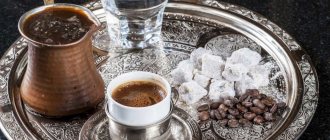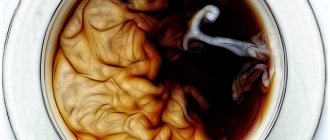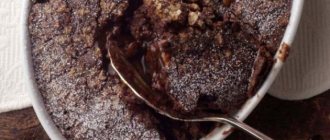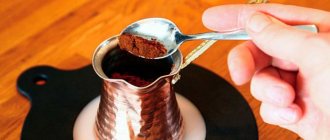Recommendations for brewing coffee in Turkish
A thick, rich, strong drink that gives an intoxicating aroma can be brewed at home, knowing the nuances of its preparation. The traditional cooking option is to use special utensils - Turks.
Important. When choosing Turkish material, you should focus on personal preferences. The form that is ideal for home use depends on how much of the drink will be prepared at a time.
It is not advisable to prepare a large amount of drink in a Turk at once.
According to professional baristas, the larger the quantity prepared in one brew, the worse the taste and aroma properties of the drink will be. The optimal volume of a coffee drink prepared in a Turk, whether it be water-based or coffee with cream, when brewed in a Turk is 100-150 ml. Before starting cooking, the Turk must be doused with boiling water in order to avoid the effect of temperature contrast. For the same purpose, the dishes can be held over steam for a short time or placed on a lit burner. Cooking according to the rules is always the right “set” of ingredients. So, for example, in order to properly brew Turkish coffee on the stove with milk, it is important to choose milk with a fat content of 3.5% and a protein content of 2% or more. The density of the foam of the finished drink will depend on the degree of fat content of the milk.
Cooking duration
A true coffee lover knows that the most important thing in the brewing process is not to “overexpose” it, and to remove the Turk from the heat in a timely manner. This is what ensures a thick, dense foam that preserves the taste and aroma as much as possible. On average, depending on the volume of the pot and the characteristics of the stove, the process of brewing an invigorating drink takes from 2 to 4 minutes. For those who decide to brew coffee with milk in a Turk, it is important to know that this process is somewhat different than when brewing with water. The main difference is that milk has the property of boiling quickly, and accordingly, the heating time is significantly reduced. Therefore, if you decide to treat yourself to milk coffee, you should carefully monitor the preparation process to prevent the milk from “running away.”
Making Turkish coffee is not as easy as it seems at first glance
Coffee drinks for gourmands
Café con Panna or Viennese coffee. The most common recipe in which coffee is served with cream. The basis of this drink is single or double espresso, which is served under a cap of whipped cream. Sometimes the cream can be sprinkled with grated chocolate, cinnamon or nutmeg.
Raf coffee. This is a kind of coffee cocktail, which in addition to espresso and cream contains vanilla sugar. All ingredients are whipped with a cappuccino maker, which is included in the coffee machine. The volume of the drink and the form in which it is served are similar to those of cappuccino. Recently, experiments with the components of this drink have become very popular. Instead of vanilla sugar, you can use vanilla syrup or a teaspoon of honey. If you add honey, you will get Honey Raf, which has become a favorite among coffee shop regulars lately. Espresso whipped with honey and cream should have a thick and viscous consistency, then you can be sure that you have prepared it correctly.
You might be interested in Methods for brewing ground coffee
Affogato. This is a beautiful name for a coffee dessert that consists of ice cream topped with a shot of espresso. It is also possible to supplement this dessert with chocolate, whipped cream, lemon or orange zest.
Affogato is a combination of espresso and ice cream.
Features of making Turkish coffee with foam
Aromatic, thick foam is the most attractive part of a freshly brewed drink, for which many people abandon the instant option in favor of the custard version. In order to achieve foam, you should warm the Turk well, then pour coffee into it at the rate of 2 teaspoons per 100 grams of water. For those who want to brew Turkish coffee with milk at home, the proportions should be observed in the same way as in the water version. Of course, you can put either more or less powder in the Turk, but this particular option is considered ideal and universal in strength.
After you have poured the powder into the Turk, it is advisable to heat it dry over a fire - it is important to be careful not to burn the Turk. This is an optional part of the ritual, but it is this technique that allows you to provide the drink with an expressive aroma.
After the powder has warmed up well, add water or milk, sugar if desired, put the Turk on the fire and bring to a boil. It is better to do this over low heat, and as soon as you notice the formation of foam, you should immediately remove the Turk to the side. This should be repeated several times, depending on whether a large or small Turk is used for cooking. The most important thing in this process is to ensure that the foam does not burst, this can greatly affect the aroma of the drink. At the end of cooking, to get rid of the grounds, you can lightly hit the Turk on the table - this way the powder will settle to the bottom, and you can enjoy delicious coffee with a nutty thick foam.
Important. Sugar plays a significant role in the formation of coffee foam. It prevents the water from heating up quickly, causing the drink to boil more slowly. This allows you to make the foam more fluffy and dense.
Preparation
It is recommended to start making cappuccino by frothing cool milk, which will immediately heat up during the process. Once foaming is complete and the milk is still in the pitcher (not to be confused with the baseball player), the espresso is prepared. When everything is ready, the milk emulsion is poured into a cup of espresso.
In cafeterias, you can often see how the barista takes milk out of the refrigerator already in the pitcher. Apparently, milk stored this way does not receive excessive degrees when poured into a milk jug at room temperature.
Turkish coffee with milk recipes
Another name for a drink brewed with pure milk is “Warsaw coffee.” If you decide to choose this cooking option at home by brewing Turkish coffee with milk, you should know that the recipes for its preparation can be completely different: from the classic gentle drink to variations with spices or honey. Therefore, for everyone who is interested in whether it is possible to brew coffee with milk in a Turk with the addition of additional ingredients, we can say a firm, confident “yes”. But the choice of additives for such a drink depends on the personal preferences of the coffee drinker. Possible options will be discussed below.
Classic recipe
The classic recipe for cooking with milk is quite simple, and is almost the same as cooking with water. Let us recall the sequence:
- Warm up the Turk.
- Add coffee powder and heat.
- Add sugar and milk (it is important not to mix the ingredients).
- Bring to a boil, remove. Repeat the procedure several times until thick foam forms.
- Pour into cups.
With milk and honey
For those who do not like or do not consume sugar, there is an alternative option for making sweet coffee. This is coffee with milk and honey. This drink is characterized by a pronounced aroma and mild taste, but there are a number of nuances that distinguish this preparation option from traditional brewing:
- honey is added not at the beginning, but at the end, to the finished drink;
- before adding honey, cool the drink to 60 degrees; at high temperatures, the waste product of bees loses its beneficial properties;
- the amount of honey per standard cup is 1-2 teaspoons.
Caramelized coffee with milk
Coffee brewed in Turkish traditionally differs from instant coffee in its beautiful caramel color. There is a method that makes it possible to achieve not only a beautiful color, but also a rich caramel aroma. To do this, you need to change the traditional order of preparing the drink.
- Pour a spoonful of sugar to taste into the bottom of the Turk and put it on the fire.
- When the sugar begins to melt, add 1-2 tablespoons of milk and stir lightly until completely dissolved.
- Add coffee powder, the rest of the milk, and continue cooking according to the traditional recipe.
On a note. Even those who don’t like to drink it with milk speak about the delicious taste of “caramel” coffee, so it’s worth trying this recipe!
Historical roots
According to Wikipedia, cappuccino (or cappuccino) translated from Italian cappuccino means capuchin. Therefore, the origin of the name of the coffee drink is associated with Europe in the 17th century, in which the monastic Order of the Capuchins existed. With all this, the capuchin was not only part of the name of the order, but also a designation of the corresponding red-brown color of the monastic robes. A little later, in the 18th century, due to the similarity of color, this was the name given to a drink made from coffee, egg yolks and cream, which began to be prepared in Austria (the German version is Kapuziner). With all this, the Italian form of the name of the drink - cappuccino - was recorded only in the 20th century.
These are the muddy posts the global library gives: cappuccino was born in Italy in the 17th century thanks to the Capuchin Order, it was drunk and prepared in Austria since the 18th century, but in Italy they began to write about it exclusively in the 20th. Maybe, naturally, I don’t understand something... Let’s return to the Italian specialists who, in the coffee trilogy, presented a picture that characterizes cappuccino.
The Bazzara brothers believe that, according to Italian tradition, to make a cappuccino you need to: prepare espresso in a cup with a volume of 150 to 200 ml of a standard portion of 25 to 30 ml, then froth from 100 to 140 ml of fresh whole milk so that equal amounts of watery water get into the cup phase of milk and its foam, pour the resulting substance into a cup of espresso.
How to choose a coffee grind
To get the perfect drink, it is important to choose the right coffee. Professionals recommend considering the following factors when purchasing:
- Shelf life. After a long stay in the package, the beans lose their aroma.
- Grinding degree. High foam and aroma are achieved by finely grinding the beans.
- Country of manufacture. Traditionally, Central and South America are considered the best in coffee growing.
- Variety Arabica is considered a universal variety. If you are a lover of strong drink, choose Robusta, or the option of combining it with Arabica in a 1:1 ratio.
Appearance
Cappuccino is served in a previously heated snow-white porcelain cup with a volume of 150 to 180 ml. The drink must have glossy snow-white foam with a uniform, silky texture, without huge bubbles, reminiscent of a watery cream.
In addition, the foam must be decorated with the appropriate espresso “ring”. Apparently, its width and smooth outline depend on the barista’s capabilities and desire to provide aesthetic pleasure.
What spices can you use?
Spices are a universal way to diversify familiar dishes. Coffee is no exception, but if you prepare this drink with milk, you need to be careful with spices. In order not to spoil the taste and aroma, “neutral” soft spices are added, such as ground cinnamon, vanilla, cardamom. These ingredients will highlight the taste of the milk drink and, at the same time, add piquancy to the drink. They should be added at the end of cooking - at the boiling stage in the Turk.
Coffee brewed with milk is a drink with a light and pleasant taste that even those who do not consider themselves coffee lovers will appreciate. Thanks to the nutritional value that milk provides, it gives a boost of vigor and energy. A variety of ways to prepare a milk drink will allow even demanding gourmets to find the ideal option.
Ingredients
Italian experts believe that the ideal amount of espresso is 25 ml: if the espresso is very “short” (not enough), then the odors will not be fully revealed, and if it is very “long” (too much), then they will dissipate. It is ideal to use fresh whole cow's milk, which has the correct organoleptic properties and can produce a velvety foam.
Discussions about the properties of milk in relation to the foam obtained from it, with a mention of the Institute of Chemistry and Milk Technology in the town of Kiel (Germany), were given in one of his own posts with discussions about latte.










